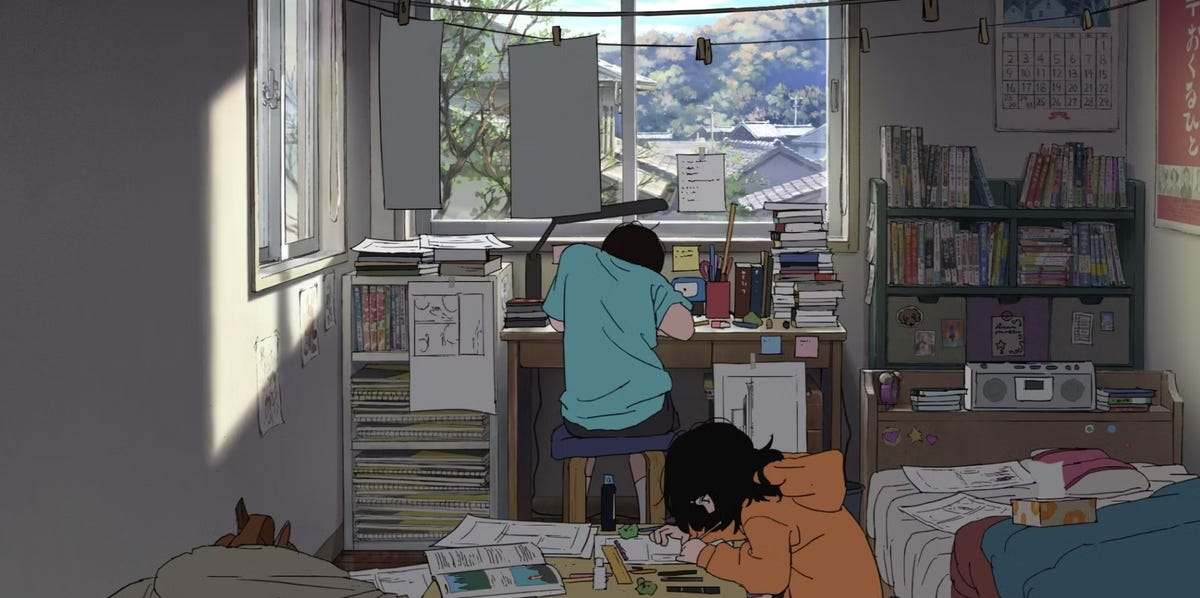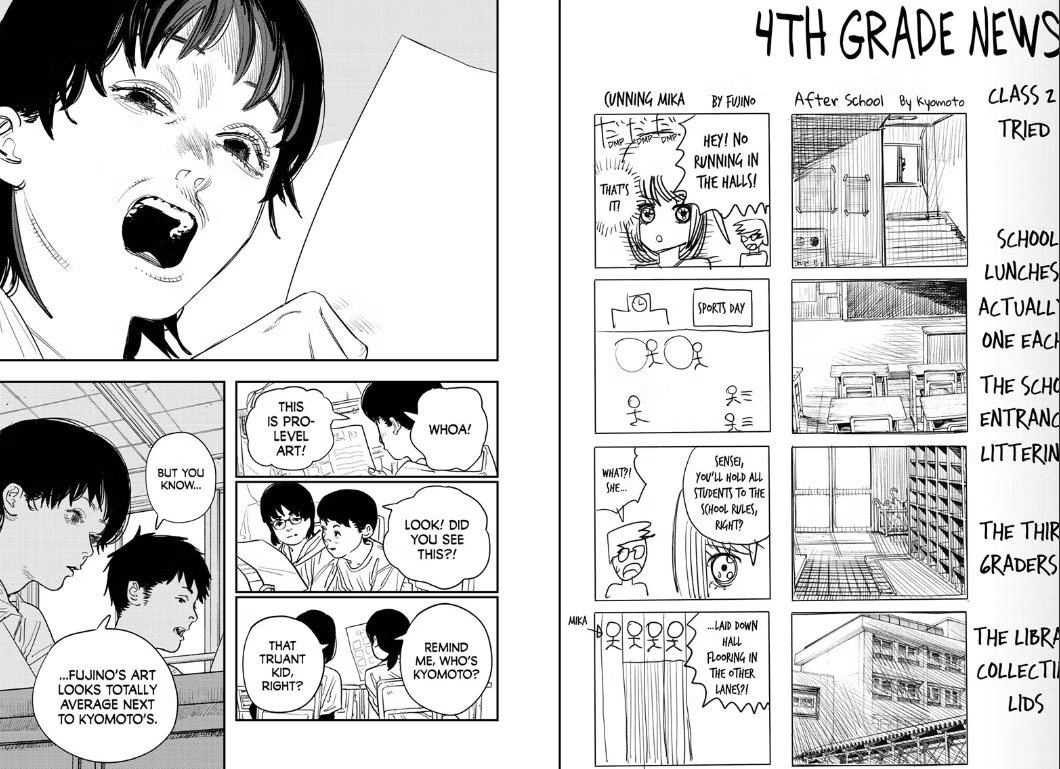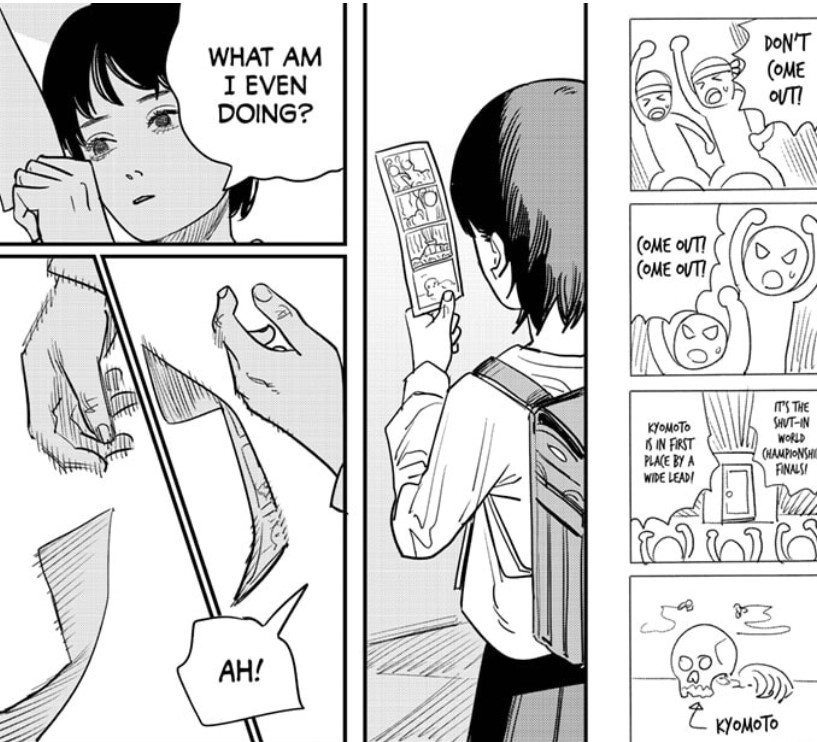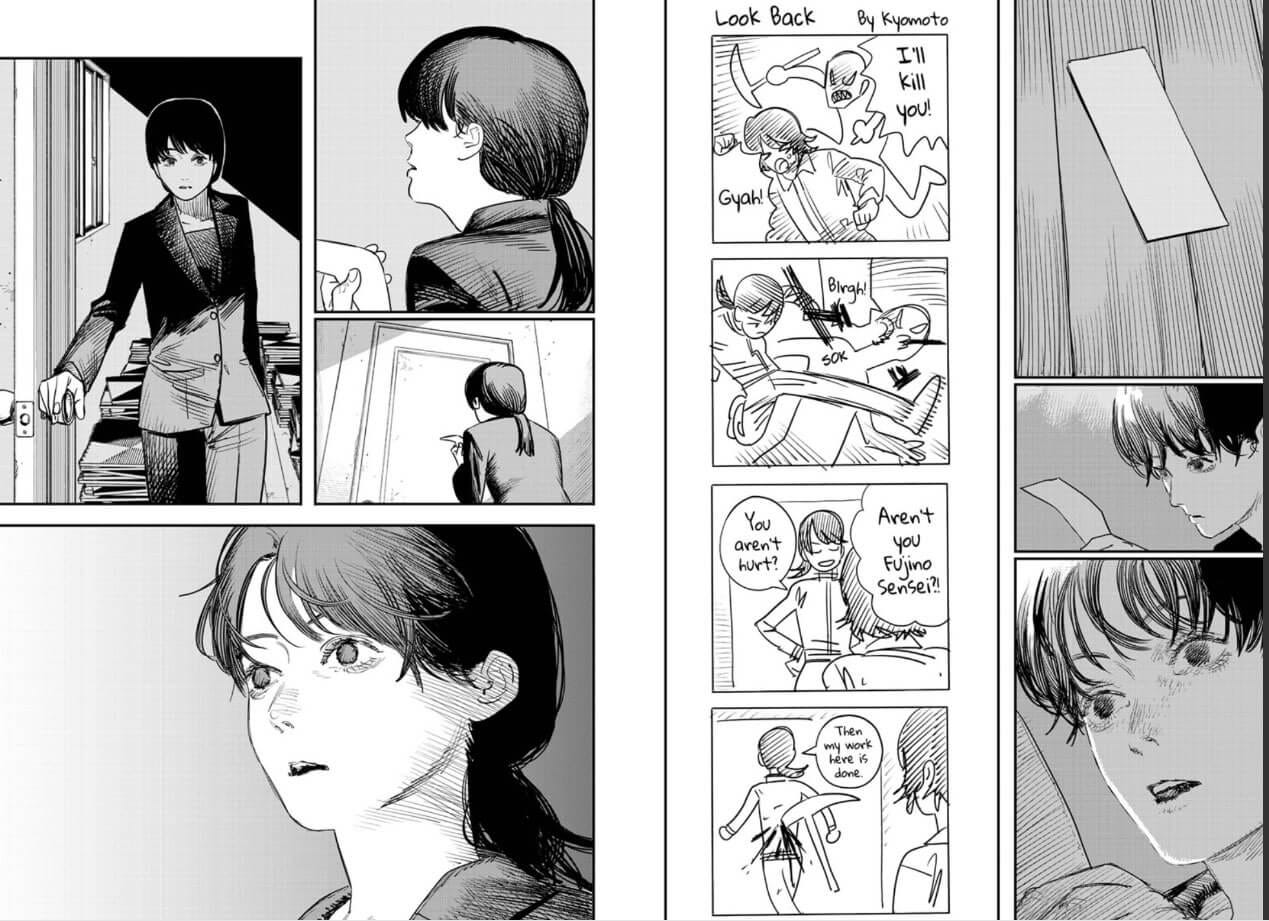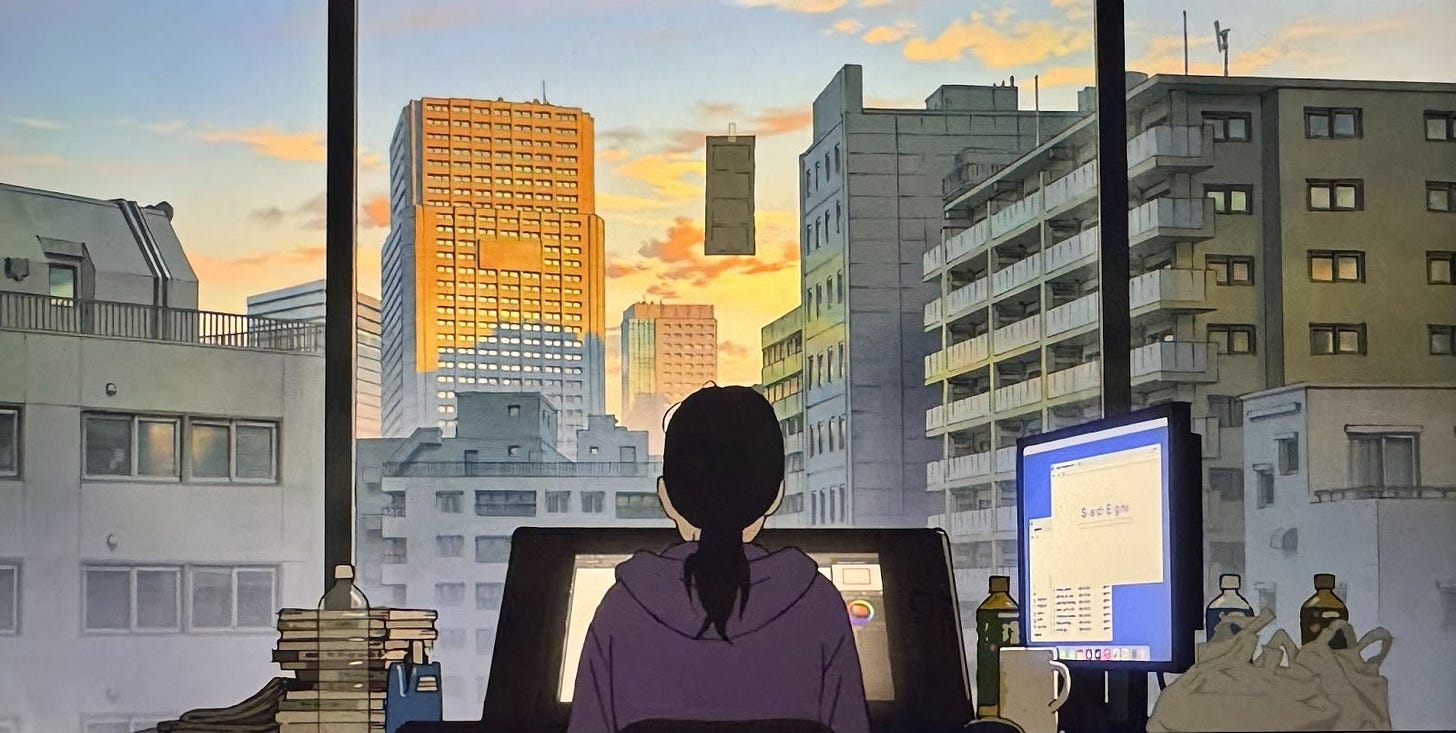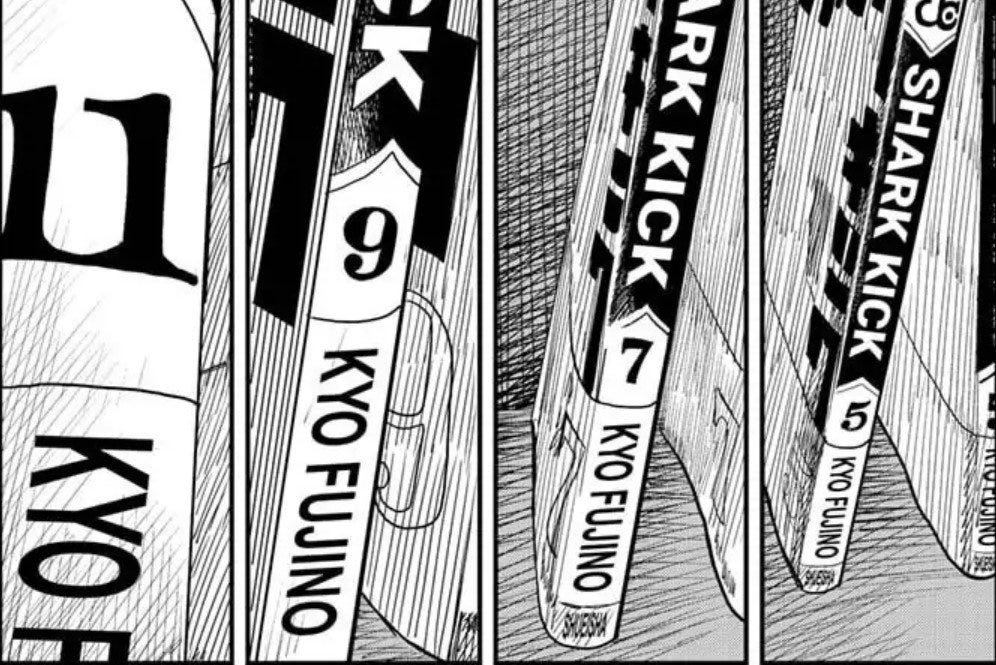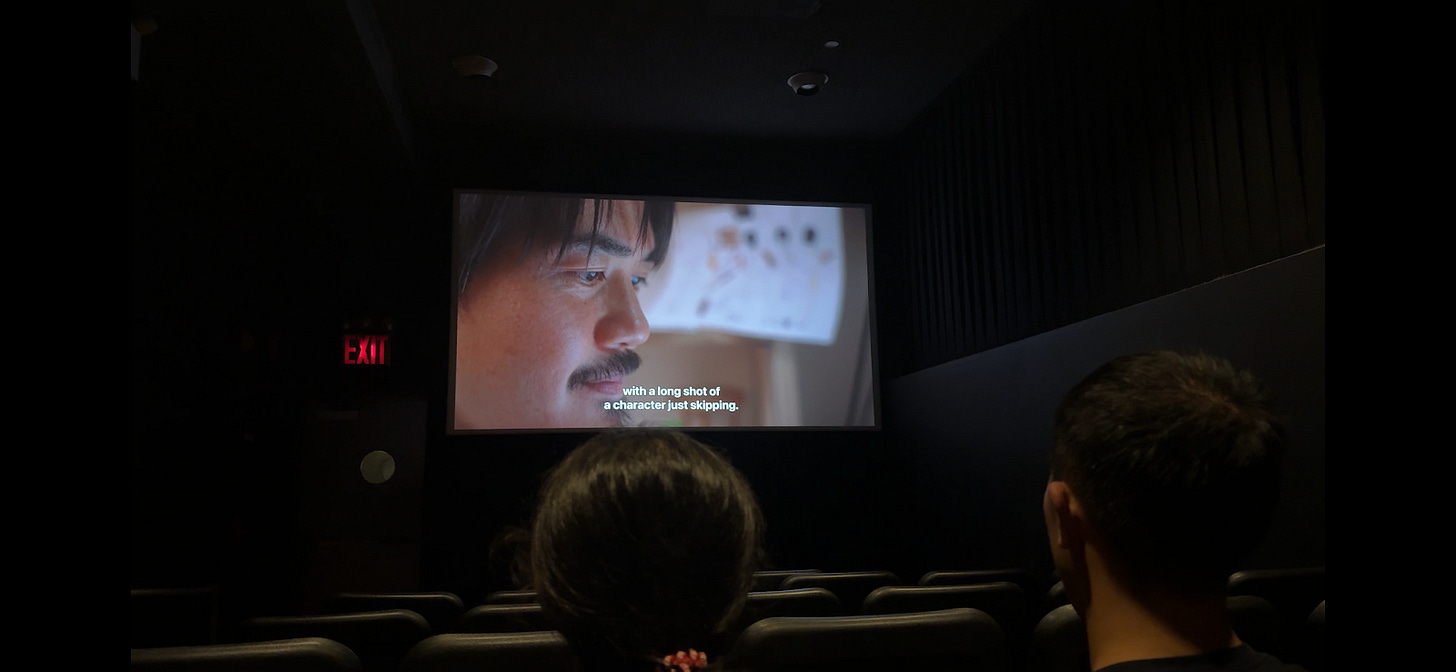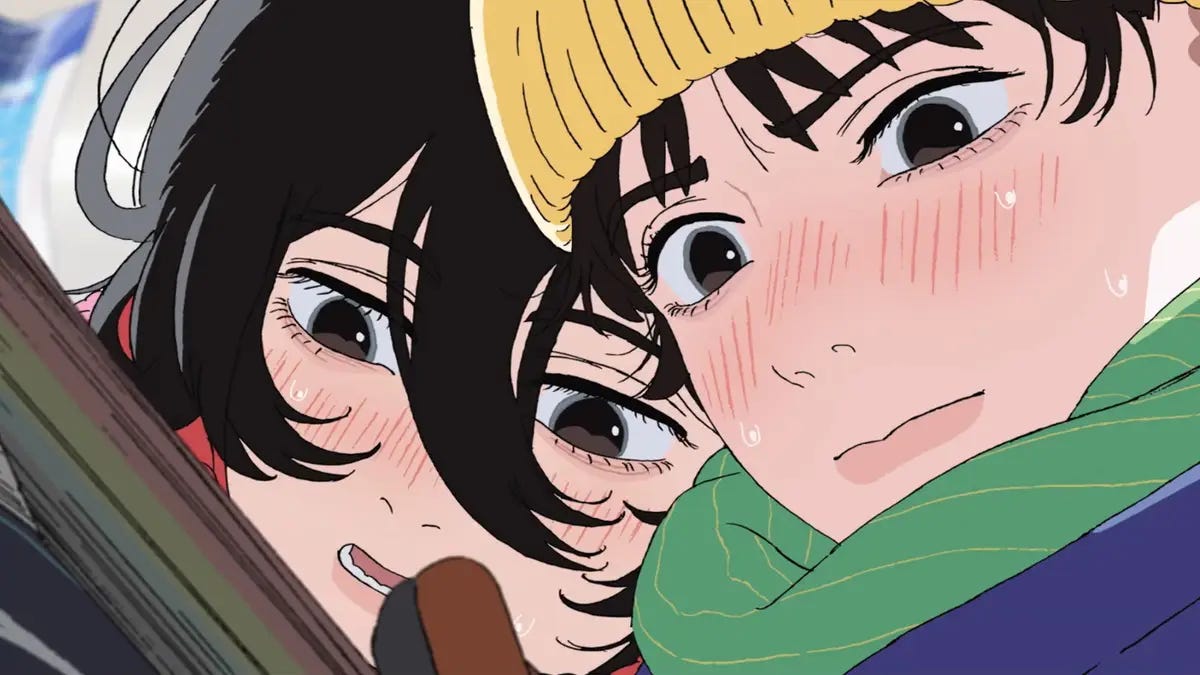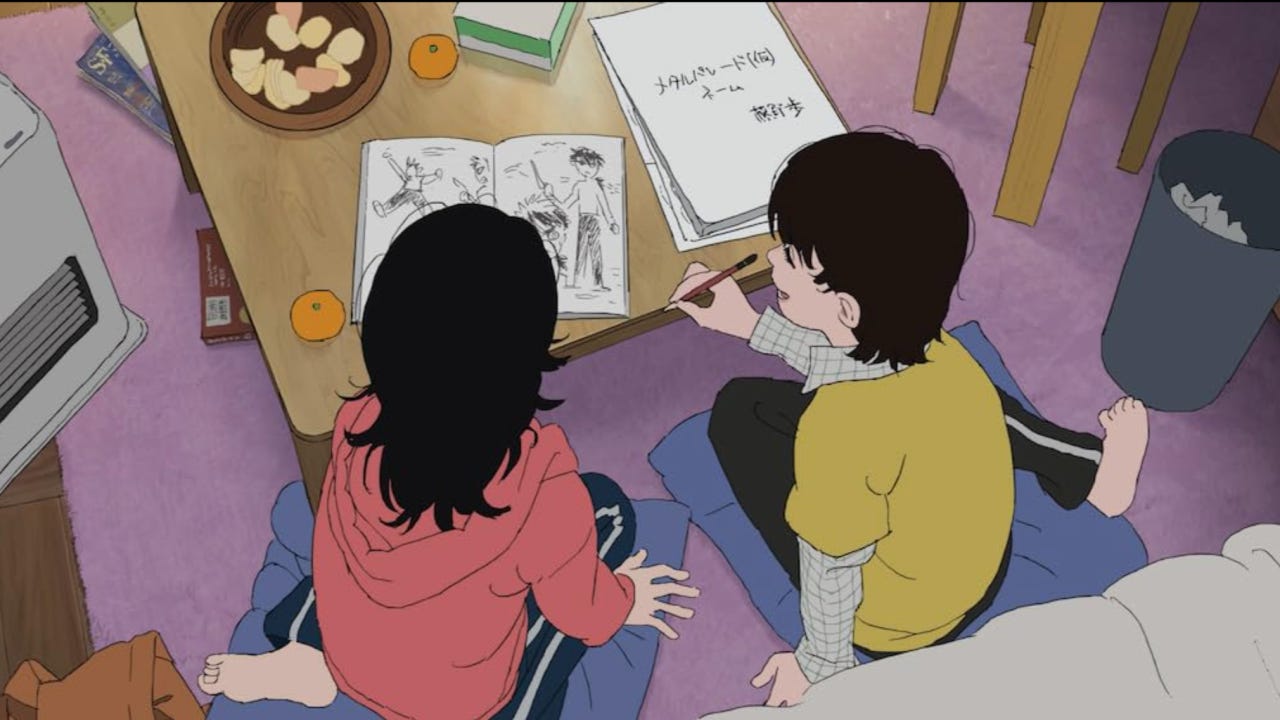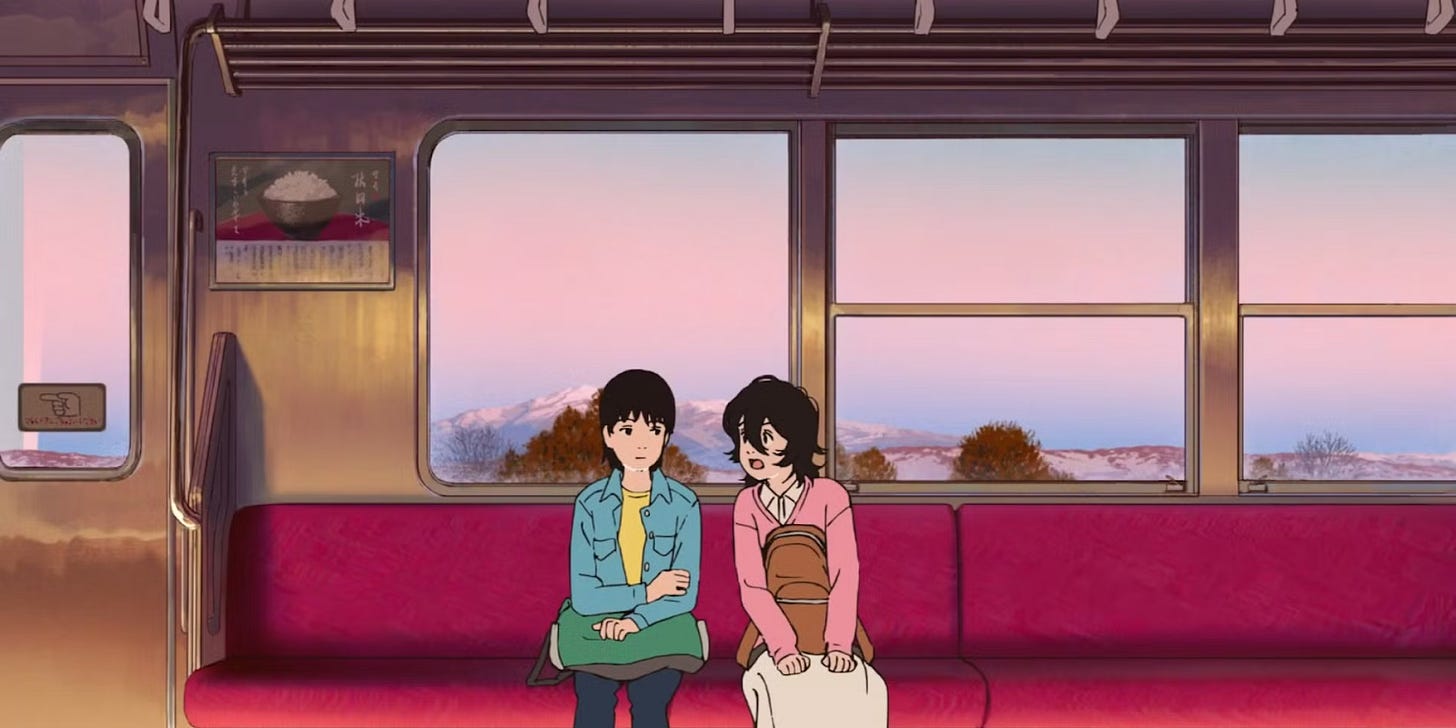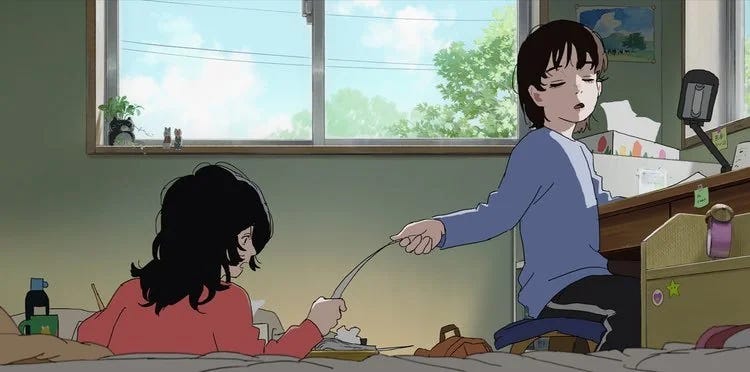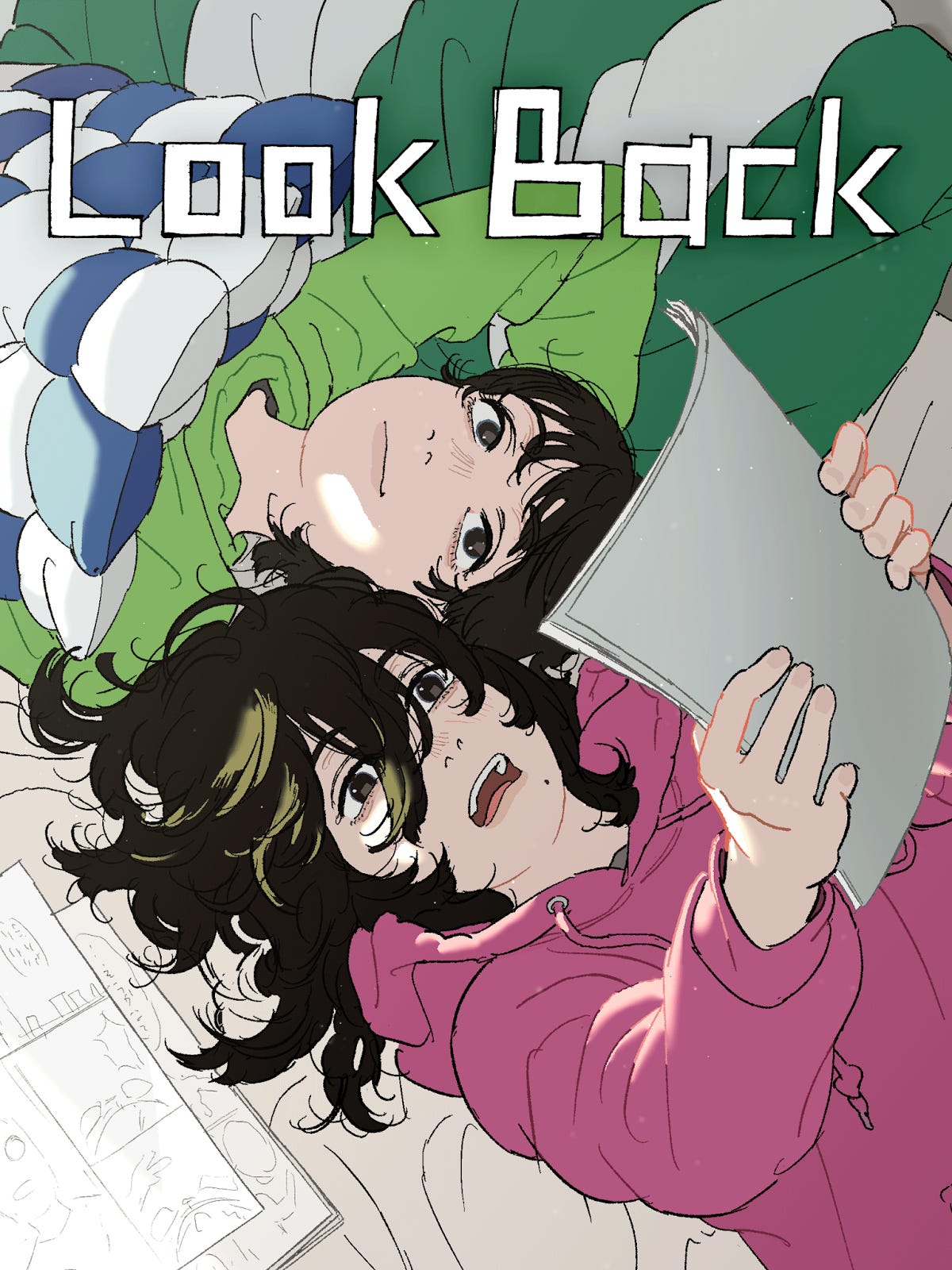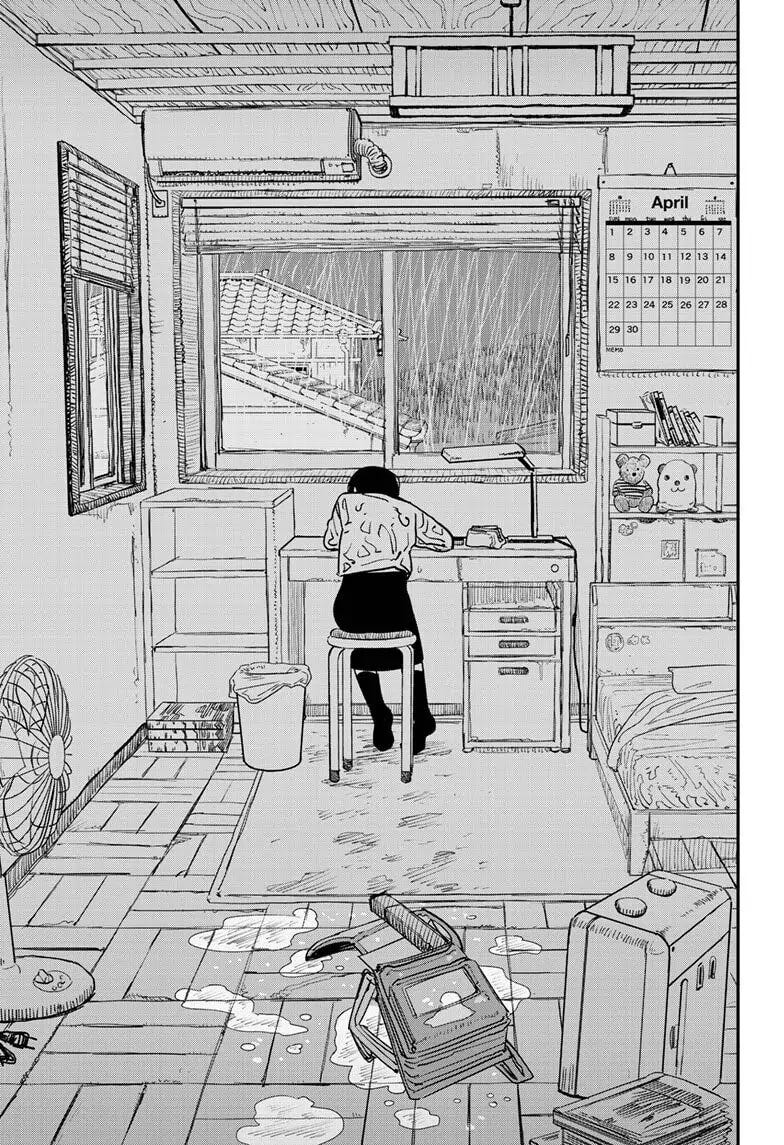generative friendships & unpeeling layers of context in look back
a review of Tatsuki Fujimoto + Studio Durian’s Look Back, TL;DR I LOVED IT
Synopsis: Look Back “tells the story of Ayumu Fujino, a young manga artist who, driven by rivalry and friendship with a reclusive classmate, strives to improve her craft and finds purpose in creating art” (Wikipedia). Manga first published by Tatsuki Fujimoto in 2021, the anime movie adaption by Studio Durian was released in 2024.
Recommended? Yes, 100% yes. You should watch this movie. Within the month of October, I watched it twice in theaters (and I’m not a movie person), and bought + read the manga in between viewings. I cried 3/3 times. I cannot say enough good things. It’s available to stream on Prime; manga can be read here.
Thoughts
warning: spoilers
We are the sum of the five people we spend the most time with, the saying goes. If you’re lucky, you find people who you not only enjoy spending time with, but who you also truly connect with. People that see the good in you, in the way that you want to be seen, as you do them. It’s rare enough to find those connections, and rarer still to find someone, a friend, a partner, a collaborator, who nurtures your spirit, that directly catalyzes life-changing growth. In Look Back, we witness such a friendship form, grow, and fray. The portrayal is a beautiful thing.
Our two main characters, Kyomoto and Fujino, are very different people. Kyomoto is a shut-in with debilitating social anxiety, while Fujino is popular, confident, and good at sports. The story starts in 4th grade. They spend two years admiring (?) each other’s art from afar (Kyomoto an adoring fangirl; Fujino pissed off and with something to prove), reading each other’s 4-panel manga strips in the school newspaper. After a fateful in-person encounter at the end of 6th grade, they spend a year creating a new manga together, day in day out, to submit to a competition as a duo. Then they invest the rest of their teenage years into making art together, publishing manga oneshots that are strange and silly and meticulously rendered. Their friendship, built upon a common interest (obsession) in creating art, complementary skill sets, and mutual respect for each other’s work, becomes the most significant relationship of their lives, up to the story’s end in their college years.
The question “Why do you draw?” is posed to Fujino near the end of the story. This question, and the idea that Fujino creates for other people, has been the focus of a lot of commentary. I don’t disagree, exactly. Fujino definitely seems driven by a general desire for compliments and to be “the best,” at least initially. What I want to call out, though, is that ultimately, it’s not positive feedback or validation from classmates, family members, teachers, the general public, etc, that drives Fujino, but a specific individual. Kyomoto not only fully encourages her art, but importantly shares a passion for manga – someone who loves the same thing she does, and is really really good at it. The quality of Kyomoto’s work in the school newspaper is what pushes Fujino to work at her craft relentlessly. Kyomoto’s fangirling and partnership is what brings Fujino back to art, even after she’s quit, and keeps her going. Look Back shows the joy and powerful purpose that comes with creating with someone whose work you acknowledge and respect – a peer, a rival – that cannot be replaced by praise or admiration from a general audience. The community of someone who understands, because they are living the same life and producing at the same quality, is the fuel that helps you reach new heights. This is the gift that Kyomoto gives Fujino.
While Kyomoto seems to have an intrinsic motivation to create and improve her craft, Fujino gives Kyomoto the gift of growth in areas outside of art, growing her confidence and life experiences, taking her out of her literal comfort zone. It’s exemplified in the scene when they first go out to celebrate in the city; Kyomoto thanks Fujino for bringing her out of the house, even though she was afraid. Without Fujino, Kyomoto likely never would have entered the manga competition, never would have created or published manga, would not have spent so much of her high school years out of the house and on adventures with a friend.
I am fascinated by these kinds of friendships, relationships, the rare kind of generative where people become exponentially greater than the sum of their parts. Some of my favorite memoirs are my favorites because they feature this kind of story – Just Kids by Patti Smith, Walk Through Walls by Marina Abramovic. JRR Tolkien and CS Lewis. Taylor Mac and Machine Dazzle, Jody Williams and Rita Sodi. I can’t get enough of it. These are the love stories I want to read about, romantic or not. There’s something about watching one person’s soul be touched and altered by the light of another, responding to it. Feel so seen, so understood, so illuminated, that you create in response to their existence. Watch someone bloom, nurture their potential. Watch each person be forever changed by the other, and to see and experience the creative output of it, like evidence of that touch. I can’t look away. There’s something mesmerizing about it. The intensity, the fervor, the buzzing energy of possibility and creation. The healing quality of shared passion and creative collaboration. Someone who brings something out of you, a tangible thing, coaxing a song out into the world, singing it with you. I crave that. And the reciprocity is so important. That generative effect on each other is what makes these partnerships so powerful. It’s not a muse-artist situation, but both and, equals, each taking and giving and replenishing, both active participants working toward a vision. It’s all collaboration. I was mesmerized by Kyomoto and Fujino. They both found something they needed in each other, and in the body of work they created together, you find the evidence of that.1
Look Back also reminded me of the power of sharing your work, and the possibilities it could lead to. The simple 4-panel manga strips is a throughline of the story, and a character in and of itself. It’s where the story begins, with the school newspaper being passed out in the 4th grade classroom, featuring a 4-panel manga strip by Fujino. Those manga strips are a form of communication between the two girls before they ever meet. Kyomoto reading Fujino’s manga strips in the school newspaper, admiring the humor and stories, is what makes her a fan of Fujino; Fujino seeing Kyomoto’s manga strips in the school newspaper, and comparing their technical skills, is what spurs her into making concerted efforts to improve her own art, in a silent rivalry and exercise in ego.
Two years later, the manga panels become a direct form of communication. Fujino is at Kyomoto’s house at their teacher’s request. Fujino draws a silly story onto a blank 4-panel manga strip, which the wind whimsically slips under Kyomoto’s room door. Kyomoto sees the panel, recognizes Fujino’s art, and it gives Kyomoto the courage to leave her room. This leads to the pair’s first in-person encounter. Fujino begins to draw again.
At the end of the story, this happenstance is mirrored – Kyomoto draws a silly story on a blank 4-panel manga strip, titled “Look Back,” which the wind slips under her door and into the hallway. Fujino, in the hallway (of an alternate reality?), sees the manga strip. It is what gives her hope enough to enter Kyomoto’s room, and eventually to “resume” her life at the literal drawing board. It’s a simple but extremely meaningful call back and reversal.
The sense of possibility imbued into the 4-panel manga strip is pretty cool, and its role in the story is a great reminder of the impact that creating and sharing just a small piece of work, literally 4 drawings scribbled in tiny boxes, can make on someone else.
One more thing. I noticed that Fujino’s Shark Kick series is published under Kyomoto and Fujino’s joint pen name, “Kyo Fujino,” even though it was entirely conceptualised and executed by Fujino. I can think of many practical reasons in the context of the story – to capitalize on the goodwill and recognition of their established name brand, to make it an easier sell to readers and publishers, etc. But I’m a sentimental person, and here’s my theory: I like to think of it as a credit and acknowledgment of Kyomoto’s impact on Fujino, an ode to their friendship, without whom Shark Kick may never have come to be. A reminder that the work we make is never solely just ours, but built on all of the people and things and events in our lives that influenced us, and formed the conditions that made our creations possible.
Though, see below for another reason that’s been floating around.
Layer 2 / Context / Reading the Subtext
I do think that a good piece of art should stand on its own. And yet, I do love hearing about the process, the context, the interviews, the interpretations, the reviews. Sometimes, this just yields some interesting fun facts, helps me learn something. Other times, the context adds so many layers to the original/source that it’s hard to imagine the art piece without it. Fujimoto is a master at subtext and layers, known for the meta and many references incorporated in his work. Look Back is no different. Peeling back some of these layers:
Details in the story hinting at autobiography, that are very obvious if you are at all familiar with Tatsuki Fujimoto (the mangaka) – the two main characters’ names (Fujino + Kyomoto) make up “Fujimoto,” that the cover art of the breakout solo manga Fujino makes looks very much like Chainsaw Man (Fujimoto’s most well known work). And some subtler ones, like the fact that the prefecture the story takes place in is very close to Fujimoto’s own hometown. Many have speculated that Fujino and Kyomoto are actually representations of different parts of Fujimoto himself (given their artistic talents are very different), others have speculated that Fujimoto had a similar friend. Neither of these theories have been confirmed. And so, going back to the question of why Shark Kick is written by Kyo Fujino – it could also be because together they represent Fujimoto.
The fact that the Look Back manga was published on the two year anniversary of the Kyoto Animation arson attack, with many similarities between the fictional and real attacks (e.g., the reason for the attack, victims were artists, result in many tragic deaths). Many have speculated that the manga, or at least the attack on Kyomoto, is in remembrance of the tragic and senseless Kyoto Animation arson attack. Even Kyomoto’s name is similar to “KyoAni,” the nickname of Kyoto Animation.
The decision to add long, substantive video interviews with the movie’s director and voice actors to the end of the cinema viewing of the movie was such a TREAT. I found out that they did this to meet the 70-minute time minimum for theaters – which I am so so glad for! I loved that this decision packages the movie+interviews into one piece of work meant to be experienced together. It is so fitting and perfect to hear from the people that created this work of art, the absolute soul and thought and energy that went into it, on the big screen, immediately following a movie they made depicting the hardships and joys of creating art. The director, Kiyotaka Oshiyama, is a total legend. He states that he drew most of the movie himself, working on it for a whole year – which is insane if you think about how much work is required in creating any animated piece. The clear reverence he had for artists and animators that worked on this film also helped. For example, he wanted to show the effort of making something and the animators and creators and human made art, an ode to those who draw and create and the effort he put in, to create a link between animators to characters, so he kept some of the overlapping lines in earlier stages that usually get deleted in the final product. And of course, the thought process behind the iconic skipping scene (IYKYK), which was only 2 pages (check) in the manga, but spanned into a much longer segment with multiple angles, incorporating some of the artists/animators flair and personality into her exaggerated movements. Hearing key artistic decisions he made helped me appreciate the experience even more. Understanding this context and details that I hadn’t even really noticed (consciously), like how he tried to adapt some unique manga background style/techniques/elements (like cross hatching) into the anime as well, how he added Fujino’s leg shaking into the anime because he personally has that habit, deepened the experience and impact of the movie after the fact. I watched the movie twice in the cinema, and both times stayed for the full interviews.
Additional Notes
This movie is under an hour, and the perfect length. The depth of emotion, impact, and layers packed in such a compact thing is incredible, as is pacing, as the movie spans 4th grade to university age.
The reason the movie beats out the manga for me, slightly, is the music. The music is absolutely phenomenal, and really heightened the visceral impact. The skipping scene is such a joy (IYKYK), which was greatly expanded in the movie. Though the manga is very much worth reading!
Standout scenes: the two girls trudging through the snow to the convenience store, Fujino skipping home in the rain after meeting Kyomoto, the numerous shots of Fujino hunched over at a table drawing, see it in the manga), when Fujino is in Kyomoto’s room and sees the signed jacket hanging on her door.
Fujino’s clever and hilarious mini comics (my favorite is the last one Fujino does before quitting, but it doesn’t get fully shown or translated in the movie!) You can really see the heart and the silly charm of Tatsuki Fujimoto’s work and stories.
The movie was only showing in 2 cinemas in NYC, I went to both! Neither were great experiences if I’m honest, but I did prefer the Regal Union (the first time), bigger screen. The manga I bought at my local independent bookshop that was having a 15% off weekend!
In the movie, there are two scenes that I wish were done slightly differently: that they showed more in the immediate aftermath where they parted ways (even just a scene or two would have helped convey deeper emotion and complexity, and I don’t think this was so much an issue in the manga). It also would have been nice if the still image montage of Kyomoto and Fujino were in motion even slightly, rather than like a slideshow (again, not an issue with the manga, because of the limitations of form.) Overall, it felt like the second half was less strong than the first half, because the first half was given more time + was so strong in the atmosphere and details.
Links
Why does Tatsuki Fujimoto draw? (linesinmotion @ Youtube, video essay and analysis)
This Movie Destroyed Me (Joey the anime man @ Youtube, review)
Review by Helmi Aziz @ Letterboxd, review with a lot of context around the author + director
Review by Walter @ Letterboxd, (why the story was personally meaningful / hearing why stories are personally meaningful and resonate with people is my favorite thing.)
Kiyotaka Oshiyama on Themes and Choices in Adapting Look Back (Q&A with director (not the one shown with the movie, interesting and new quote about how he inserted some of his own habits into the film/Fujino as tiny details, like how he shakes his leg when sitting)
Kiyotaka Oshiyama's 'Look Back' is the Most Striking Anime of the Year (Review + director interview)
Finding the Right People (starting from nix @ substack)
“Mythmakers: The Remarkable Fellowship of C.S. Lewis and J.R.R. Tolkien,” with John Hendrix (Wade Center @ Youtube)
CS Lewis and JRR Tolkien: A Friendship that Created Worlds (Natasha Burge @ Substack)
it takes two to think (starting from nix @ Substack) [added 1/7/25]
Stills I Liked:
Questions For You
If you watched Look Back - what did you think?
Do you have a similar friend-peer-rival-collaborator with a similar transformative effect on your life? Or, more broadly, anyone that had a similar generative impact on you? How or why?
Any similar pairs I should learn more about?
How do you like to discuss or engage in narrative art (movies, books, shows, etc) after you’ve viewed it? Do you seek out further context, and if so, why?
And while I don’t want to over-romanticise their friendship, because there were clearly toxic aspects to it (e.g., the way Kyomoto idolized Fujino, the way Fujino responded to Kyomoto’s decision to go to art school by tearing her down and hiding her tears), I thought their falling out was a very real portrayal of immature adolescent behavior, poor communication, and how we hurt the people we love. All of this only served to heighten the emotion as the story progressed, and showed the complexities and regrets of a flawed character (Fujino).


